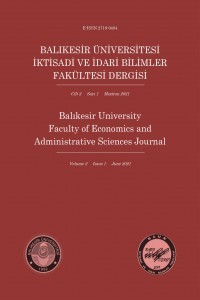Nüfusun Yaşlanmasının Doğrudan Yabancı Yatırım Girişleri Üzerine Etkisi: ASEAN-5 Ülkeleri Üzerine Panel Veri Analizi
Küresel yaşlanma problemi, beraberindeki ekonomik etkileri kapsamında sıklıkla tartışılmakta ve araştırma konusu olmaktadır. Nüfusun yaşlanmasının doğrudan yabancı yatırım girişleri üzerine etkileri de bu kapsamda ilgi çekici bir diğer konudur. Bu çalışmanın amacı nüfus yaşlanmasının doğrudan yabancı yatırım girişleri üzerine etkisinin araştırılmasıdır. Belirtilen amaç doğrultusunda ASEAN-5 ülkeleri olarak bilinen Malezya, Endonezya, Filipinler, Singapur ve Tayland’a ait 1970-2019 dönemini kapsayan veriler kullanılarak dengeli panel veri analizi yapılmıştır. Nüfus yaşlılığı göstergeleri olarak yaşlı bağımlılık oranı ve 65 yaş ve üzeri nüfusun toplam nüfus içindeki payı kullanılmıştır. Doğrudan yabancı yatırımlar (net girişler) bağımlı değişken olup çalışmaya gayrisafi sabit sermaye oluşumu ve ticari açıklık oranı gibi kontrol değişkenleri dahil edilmiştir. Yapılan panel veri analizi sonucunda ASEAN-5 ülkelerinde nüfus yaşlılığı arttıkça (yaşlı bağımlılık oranı ve 65 yaş ve üzeri nüfusun toplam nüfus içindeki payı arttıkça) doğrudan yabancı yatırımların arttığı bulgusuna ulaşılmıştır.
Anahtar Kelimeler:
nüfus yaşlılığı, doğrudan yabancı yatırımlar, ASEAN-5 ülkeleri, panel veri analizi
The Effect of Population Ageing on Foreign Direct Investment Inflows: Panel Data Analysis on ASEAN-5 Countries
The problem of global aging is frequently discussed and researched within the scope of its accompanying economic effects.The effects of population aging on foreign direct investment inflows is another interesting issue in this context.The aim of this study is to investigate the effect of population aging on foreign direct investment inflows.For the stated purpose, balanced panel data analysis was conducted using data covering the period from 1970 to 2019 belonging to Malaysia, Indonesia, Philippines, Singapore and Thailand, known as ASEAN-5 countries.The age dependency ratio (old) and the share of the population aged 65 and over in the total population were used as indicators of population aging.Foreign direct investment (net inflows) is the dependent variable and control variables such as gross fixed capital formation and trade openness are included in the study.As a result of the panel data analysis, it was found that foreign direct investments increased as the population aged in ASEAN-5 countries increased (as the age dependency ratio (old) and the share of the population aged 65 and over increased in the total population).
___
- Alsan, M., Bloom, D., & Canning, D. (2006). The effect of population health on foreign direct investment inflows to low and middle income countries, World Development, 34(4), 613-630.
- Barany Z. L., Coeurdacier N., & Guibaud S., (2018). Capital Flows in an Aging World. Sciences Po:Paris.
- Bloom, D. E., Chatterji, S., Kowal, P., Lloyd-Sherlock, P., McKee, M., Rechel, B., Rosenberg, L., & Smith, J. P. (2015). Macroeconomic implications of population ageing and selected policy responses, The Lancet, 385(9968), 649-657.
- Brooks, R. (2000). Population aging and global capital flows in a parallel universe. IMF Working Paper, WP/00/151, International Monetary Fund.
- Chen, J., Jiang, Y., Wang, B., (2017). Population aging, FDI and Financial Development: A threshold model analysis based on interprovincial panel data in China, Business Research.
- Çoban, M. N. (2021). Gümüş Ekonomi (2. Baskı). Gazi Kitabevi.
- Erdogan, M., & Unver, M. (2015). Determinants of foreign direct investments: dynamic panel data evidence, International Journal of Economics and Finance, 7(5), 82-95.
- Gannon, F., Le Garrec, G., & Touze, V. (2020). The South’s demographic transition and international capital flows in a financially integrated world economy, Journal of Demographic Economics, 86, 1-45.
- Lim, J. S., & Kim, Y. R. (2017). Effects of population aging on international investment (in Korean), BOK Working Paper 2017.
- Liu, W. & McKibbin, W. J. (2019). Global demographic changes and international capital flows. David Bloom (Ed.), Live long and prosper? The economics of ageing populations. CEPR Press.
- Mitra, R. & Abedin, M. T. (2020a). Population ageing and FDI inflows in OECD countries : a dynamic panel cointegration analysis, Applied Economics Letters, 28(13), 1071-1075.
- Mitra, R. & Abedin, M. T. (2020b). Population ageing and FDI inflows in Japan: ARDL approach to cointegration analysis, Economics Bulletin, 40(2), 1814-1825.
- Mitra, R. & Guseva, M. E. (2021). Does Population Ageing Reduce FDI Inflows in OECD Countries? Evidence from Bayesian Panel VAR Estimates. Aswini Kumar Mishra, Ajay, S. Winze, Rajorshi Sen Gupta, Rammohan Menon (Eds.), Advances in innovation, trade and business. Springer International Publishing.
- Narciso, A. (2010). The impact of population ageing on international capital flows, MPRA Paper 26457, University Library of Munich, Germany.
- Ogura, S., & Jakovljevic, M. (2014). Health financing constrained by population aging - an opportunity to learn from Japanese experience, Serbian J Exp Clin Res. , 15: 175–81. doi: 10.2478/SJECR-2014-0022.
- Orlicka, E. (2015). Impact of population ageing and elderly poverty on macroeconomic aggregates, 3rd Economics & Finance Conference, Rome, Italy, April 14-17, 2015 and 4th Economics & Finance Conference, London, UK, August 25-28 2015.
- Sander, M., Oxlund, B., Jespersen, A., Krasnik, A., Mortensen, E. L., Westendorp, R. G. J., & Rasmussen, L. J. (2015). The challenges of human population ageing, Age and Ageing, 44(2), 185-187.
- Talukdar, Z. H., & Parvez, A. A. (2017). Measuring the impact of population health and education on foreign direct investment: panel evidence from 46 countries, Asian Economic and Financial Review, 7(12), 1242-1255.
- Tomohara, A. (2017). Does immigration crowd out foreign direct investment inflows? Tradeoff between contemporaneous FDI-immigration substitution and ethnic network externalities, Economic Modelling, 64, 40-47.
- Xi, Y., & Xueyi, W. (2020). Bilateral effects of ageing on FDI: Spillover or extrusion? , Population Research.
- Yayın Aralığı: Yılda 2 Sayı
- Başlangıç: 2020
- Yayıncı: Balıkesir Üniversitesi
